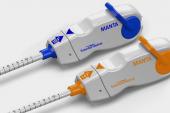FDA Data Raise Red Flags for Suture-Based Vascular Closure Devices
Adverse-event reports show complications can be serious, senior author Ron Waksman says. “People have to be aware of it.”

Suture-based vascular closure devices (VCDs) can, in real-world practice, lead to complications and even death, analysis of a US Food and Drug Administration database confirms. These adverse outcomes varied by whether the VCD in question was the decades-old Prostar XL or the newer Perclose ProGlide (Abbott), which arrived on the US market in 2018.
The researchers caution, however, that the data they report don’t capture the true incidence, since the “denominator” of the total case count over the years is hard to pin down.
Use of large-bore closure devices is expected to rise given the growth in TAVI and structural heart procedures, percutaneous left ventricular assist device implantation, and endovascular interventions. Beyond the suture-based VCDs, other designs have now arrived—for instance, following results from the SAFE-MANTA trial, the Manta (Essential Medical), which combines a bioresorbable collagen plug and suture system to seal the puncture site, received FDA approval in February 2019. Manta as well as the InClosure VCD (InSeal Medical) and PerQseal (Vivasure Medical) all have had CE Mark approval for years in Europe.
Senior author Ron Waksman, MD (MedStar Washington Hospital Center, Washington, DC), said this study is one of several by their group to pull numbers from the FDA’s Manufacturer and User Facility Device Experience database, known as MAUDE. Other papers have focused on topics as diverse as rotational atherectomy, the Sentinel cerebral protection device (Boston Scientific), and guide extension catheters in PCI, as well as the aforementioned Manta device.
“There’s a lot of revelations when you look at the MAUDE database regarding almost every device,” he told TCTMD, adding, “With no one actually reporting [real-world use] in a systematic way, that’s the best source to know how each of those devices perform.”
The latest results, with Brian C. Case, MD (MedStar Washington Hospital Center), as lead author, were published online recently in Catheterization and Cardiovascular Interventions.
For Waksman, the takeaway for large-bore closure devices is: “You need to be very, very careful, because there are serious complications. . . . People have to be aware of it.”
There’s a lot of revelations when you look at the MAUDE database regarding almost every device. Ron Waksman
Hemal Gada, MD (UPMC Pinnacle, Harrisburg, PA), commenting on the findings for TCTMD, agreed. Whether based on sutures or another approach, he said, “in general, any kind of vascular closure device is going to have some technical challenges. I think that’s the big issue here—people may not be deploying these devices in the way that’s the gold standard.”
Looking at the current results, there’s a mix of device-related and operator-error complications, Gada noted, characterizing the potential overlap between the two as a Venn diagram. Given that the adverse outcomes reported to MAUDE aren’t adjudicated, he cautioned that they should be taken “with a grain of salt,” a sentiment echoed by the study authors. “I do think what it does is alert the practitioner that these things do take a lot of practice to get really good at them,” Gada stressed.
Perclose ProGlide and Prostar XL
After eliminating duplicate entries, there were 827 unique reports for Perclose ProGlide and 175 for Prostar XL in MAUDE, Case and colleagues found.
With the Perclose ProGlide VCD, there were 404 reports of injury, one of which involved death. Suture-related malfunction was the most-frequent difficulty with the device itself, resulting in 212 reports to MAUDE.
With the Prostar XL device, there were 94 reports of injury, including one death. Here, the most common device malfunction was failed deployment, mentioned in 44 reports.
For both devices, the most-common adverse outcomes were bleeding from vessel injury, hematoma, and thrombus, followed by a few rare instances of vessel occlusion (specific to Perclose ProGlide) and pseudoaneurysm. Treatment typically consisted of surgical repair. Other remedies included manual compression, percutaneous covered stent, balloon, blood transfusion, patch angioplasty, thrombin injection, and CPR.
These patterns are revealing, Case et al say.
“The noted safety of the Prostar XL device versus the Perclose ProGlide device may be due to the differing design and characteristics of the two devices,” the investigators suggest. “While the Prostar XL device delivers four needles simultaneously from within the arterial lumen, the Perclose ProGlide device delivers only two needles. Unlike the Prostar XL device, the ProGlide delivers its needles independently, thus lowering the risk of delivery failure.”
Particularly in high-risk patients, it’s important to choose a device that’s easier to use and thus, in theory, would be less prone to complications, according to Case and colleagues. The Prostar device, they note, involves more than 30 steps for deployment and retraction; the ProGlide device, by contrast, requires 10 to 12 steps. “There are also ways to decrease the risk of infection and limb ischemia associated with both devices,” they write. “These steps include using sterilization techniques and readying the arteriotomy site before closure, as well as utilizing ultrasound guidance when gaining access into a vessel lumen.”
Education to increase operator expertise and thoughtful patient selection can both minimize risk, they conclude.
Operator Proficiency a Must
Gada similarly noted that when using device systems that require upwards of a dozen or more steps, “there’s a lot of room for technical errors to rear their ugly heads.”
In terms of how to gain the skills, Gada suggested using dry models and employing the devices first in routine catheterization procedures before proceeding to large-bore interventions. Operators can engage with colleagues and vendors to learn best practices. Key aspects are understanding the steps involved, how to deploy the devices, and, importantly, “understanding the right tension to pull on the suture [since] it seems that the suture breakage was the biggest issue,” Gada advised. “Again, that could be related to operator proficiency with the suture-based vascular closure devices. . . . A lot of these are technical things that could be overcome with practice.”
Regarding patient selection, he said, “the biggest resounding thing is just [to] do it on vessels that are clean and healthy up-front, especially if you’re on the left hand of your learning curve, before you get to more-challenging anatomy.”
To TCTMD, Waksman cautioned that the MAUDE data aren’t definitive and all events were self-reported by concerned operators. “We assume that most of the complications are not being reported. This is not mandatory action—it’s voluntary reporting. You really need to be mad at something to report it, right? Or maybe a good citizen,” he said, adding that many early-career physicians aren’t aware that MAUDE exists.
Waksman hopes their papers will “encourage individuals to go to the database—it’s not that complicated—and to report it. It’s a great tool.”
In the era of vascular closure devices we have now, I think that they’re perfectly fine for 98-plus percent of cases. Hemal Gada
MedStar has switched over to Manta as the default closure device for TAVI, said Waksman, which he described as “a big change.” They haven’t seen much difference in complications since the shift, though it is simpler to use, he said. “We’re still assessing that and there’s also a learning curve. Definitely it’s easier from the operator perspective, but I couldn’t find any data to support that it’s more effective or safer when it’s compared to these suture-based closure devices. . . . If you have the same outcome, then you win by simplicity.”
Gada, referring to the Manta paper by the MedStar group, said what it found is “very, very similar.”
Yet in his opinion, there are important differences between the VCDs. With suture-based devices, many complications can be handled by using another closure device or a covered stent, with fewer requiring vascular surgery or cutdown, said Gada, adding, “If you miss with the Manta—if you deploy it too deep in the vessel or, God forbid, you deploy it too shallow—all of those things likely have surgical ramifications to them. This isn’t something you can easily fix by putting in a covered stent, blowing up a balloon, putting another device in.”
He pointed out that the two deaths in the Perclose/Prostar report were related to hematoma or bleeding, whereas there were five deaths in the Manta report, despite that data set containing fewer patients. With the latter device, causes of death ranged from bleeding to pseudoaneurysm and vessel occlusion.
While there’s always room for improvement, which newer-generation VCDs may provide, Gada said that “in the era of vascular closure devices we have now, I think that they’re perfectly fine for 98-plus percent of cases. It’s just really dependent on the technical proficiency of the operator and so we need to keep pushing for hands-on workshops at the meetings when they open back up.”
Caitlin E. Cox is News Editor of TCTMD and Associate Director, Editorial Content at the Cardiovascular Research Foundation. She produces the…
Read Full BioSources
Case BC, Kumar S, Yerasi C, et al. Real-world experience of suture-based closure devices: insights from the FDA Manufacturer and User Facility Device Experience. Catheter Cardiovasc Interv. 2021;Epub ahead of print.
Disclosures
- Waksman reports serving on the advisory boards of Amgen, Boston Scientific, Cardioset, Cardiovascular Systems Inc, Medtronic, Philips, and Pi-Cardia Ltd; being a consultant to Amgen, Biotronik, Boston Scientific, Cardioset, Cardiovascular Systems Inc, Medtronic, Philips, and Pi-Cardia Ltd; receiving grant support from AstraZeneca, Biotronik, Boston Scientific, and Chiesi; being on the speakers bureaus of AstraZeneca and Chiesi; and being an investor in Med-Alliance.
- Case and Gada report no relevant conflicts of interest.





Comments